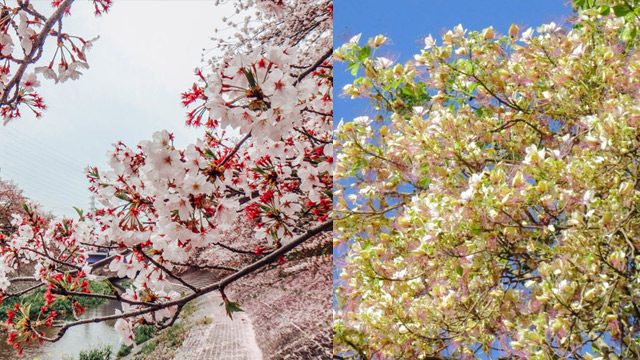SUMMARY
This is AI generated summarization, which may have errors. For context, always refer to the full article.

MANILA, Philippines – To Filipinos who are fans of Japanese culture, seeing cherry blossom trees bloom in the Philippines will be a dream come true. Those famed pink blossoms that most Filipinos will only get to see through their televisions or computer screens may finally shed its blossoms atop the province of Benguet.
However, the same excitement can’t be said for the members of Haribon Foundation and some netizens, who expressed their concern about the planting of 30 cherry blossom trees among other native Japanese trees in a cherry blossom or sakura park that will soon rise in Atok, Benguet.
After all, netizens said that there are many native Philippine trees which are just as beautiful as the sakura tree.
Our very own
The Bagawak-morado (Clerodendrum quadriloculare), Siar (Peltophorum pterocarpum), Malabulak (Bombax ceiba), Molave (Vitex parviflora) and Bagras (Eucalyptus deglupta), as well as rare endemics like the Mangkono (Xanthostemon verdugonianus), Yakal (Shorea astylosa) and Pulang Lauan (Shorea negrosensis), are just some of the trees in the country that could rival the beauty of the cherry blossoms, according to Kris N. Ordoñez.
“Planting and promoting exotic species not only compromises the native and [especially the] endemic biodiversity, it also creates a mentality that the Philippine flora doesn’t have an identity of its own, that it is not something the Filipino people can be proud of,” Ordonez added in a post.
Another Facebook user, Maia Lorlina Tanedo, posted about the Salimbobog or Balai Lamok tree which closely resembles the Japanese cherry blossoms. Tanedo is a member of the Wild Bird Club of the Philippines.
“While the Japanese have been working hard to promote their beautiful cherry blossoms, we Filipinos have been busy imitating them: promoting what is theirs. We should be busy promoting what is ours We should be inspired by their efforts, not only of the actual plant,” Tanedo said in a post.
Biodiversity
These sentiments were echoed by Haribon Foundation’s Albert Balbutin, claiming that “there are beautiful flowering native trees in the Philippines that the world has yet to discover. These trees can bring economic and ecological benefit to local Benguet communities, or any community that desires to attract tourists with the use of trees.”
Beyond the need to appreciate the Philippine flora, Haribon also highlighted the possible disruption in Atok’s local biodiversity that planting ‘exotic trees’ like cherry blossoms may cause.
According to Haribon Foundation, an organization advocating for environment preservation, the cherry blossom tree as an “exotic tree” has not yet adapted to Philippine weather, biodiversity, local wildlife, and soil unlike native trees.
“Cherry blossom trees may potentially become invasive, and halt the ecological process of the area in Benguet where they are being planted. They may not survive long, and if they do, they may not attract vast biodiversity like birds, insects, and other wildlife like native trees do,” Balbutin added.
He also pointed out how the cherry blossom trees may end up replacing native trees in the area resulting to monoculture or the vegetation of a single species in a place.
“Diseases and pests invade areas planted with exotic trees and can eventually wipe out entire areas of biodiversity. It can result in nutrient imbalances in the soil and plants,” Balbutin said.
Strengthening and weakening relationships
The initiative to plant sakuras in Atok is part of the celebration of the 40th anniversary of Benguet province and Japan’s Kochi prefecture’s diplomatic ties. The park will be situated 2,000 meters above sea level and will be opened to campers. (READ: Planning your cherry blossom Japan adventure: 5 beautiful viewing spots)
But while the gesture was said to be an effort to strengthen our ties with Japan, Balbutin added that it might, in exchange, “weaken ecological relationships between trees, wildlife, and local communities.”
In Japan, crowds of tourists and locals alike, flock to parks during springtime around late March to early May to view the light pink national flower, cherry blossoms in full bloom. – Rappler.com
A Rappler intern, Tessa Barre studies journalism at the University of the Philippines – Diliman.
Add a comment
How does this make you feel?
There are no comments yet. Add your comment to start the conversation.